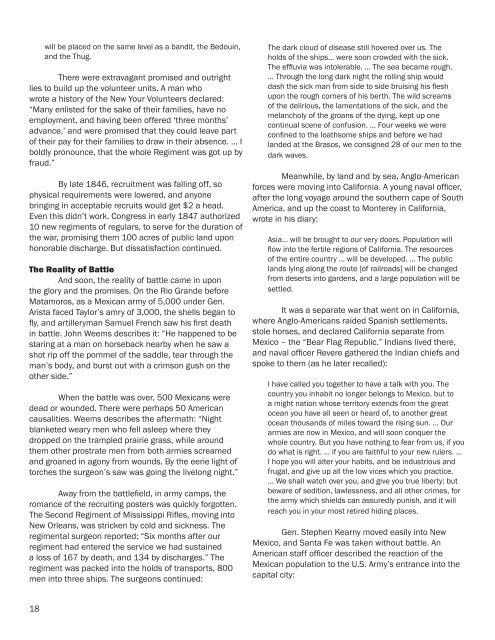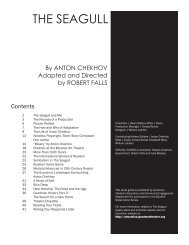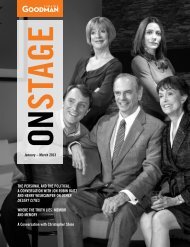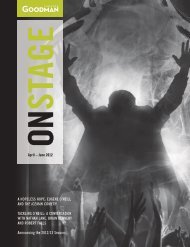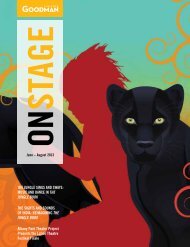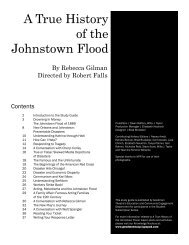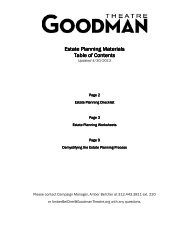El Nogalar Study Guide (9MB) - Goodman Theatre
El Nogalar Study Guide (9MB) - Goodman Theatre
El Nogalar Study Guide (9MB) - Goodman Theatre
Create successful ePaper yourself
Turn your PDF publications into a flip-book with our unique Google optimized e-Paper software.
will be placed on the same level as a bandit, the Bedouin,<br />
and the Thug.<br />
There were extravagant promised and outright<br />
lies to build up the volunteer units. A man who<br />
wrote a history of the New Your Volunteers declared:<br />
“Many enlisted for the sake of their families, have no<br />
employment, and having been offered ‘three months’<br />
advance,’ and were promised that they could leave part<br />
of their pay for their families to draw in their absence. … I<br />
boldly pronounce, that the whole Regiment was got up by<br />
fraud.”<br />
By late 1846, recruitment was falling off, so<br />
physical requirements were lowered, and anyone<br />
bringing in acceptable recruits would get $2 a head.<br />
Even this didn’t work. Congress in early 1847 authorized<br />
10 new regiments of regulars, to serve for the duration of<br />
the war, promising them 100 acres of public land upon<br />
honorable discharge. But dissatisfaction continued.<br />
The Reality of Battle<br />
And soon, the reality of battle came in upon<br />
the glory and the promises. On the Rio Grande before<br />
Matamoros, as a Mexican army of 5,000 under Gen.<br />
Arista faced Taylor’s amry of 3,000, the shells began to<br />
fly, and artilleryman Samuel French saw his first death<br />
in battle. John Weems describes it: “He happened to be<br />
staring at a man on horseback nearby when he saw a<br />
shot rip off the pommel of the saddle, tear through the<br />
man’s body, and burst out with a crimson gush on the<br />
other side.”<br />
When the battle was over, 500 Mexicans were<br />
dead or wounded. There were perhaps 50 American<br />
causalities. Weems describes the aftermath: “Night<br />
blanketed weary men who fell asleep where they<br />
dropped on the trampled prairie grass, while around<br />
them other prostrate men from both armies screamed<br />
and groaned in agony from wounds. By the eerie light of<br />
torches the surgeon’s saw was going the livelong night.”<br />
Away from the battlefield, in army camps, the<br />
romance of the recruiting posters was quickly forgotten.<br />
The Second Regiment of Mississippi Rifles, moving into<br />
New Orleans, was stricken by cold and sickness. The<br />
regimental surgeon reported: “Six months after our<br />
regiment had entered the service we had sustained<br />
a loss of 167 by death, and 134 by discharges.” The<br />
regiment was packed into the holds of transports, 800<br />
men into three ships. The surgeons continued:<br />
The dark cloud of disease still hovered over us. The<br />
holds of the ships… were soon crowded with the sick.<br />
The effluvia was intolerable. … The sea became rough.<br />
… Through the long dark night the rolling ship would<br />
dash the sick man from side to side bruising his flesh<br />
upon the rough corners of his berth. The wild screams<br />
of the delirious, the lamentations of the sick, and the<br />
melancholy of the groans of the dying, kept up one<br />
continual scene of confusion. … Four weeks we were<br />
confined to the loathsome ships and before we had<br />
landed at the Brasos, we consigned 28 of our men to the<br />
dark waves.<br />
Meanwhile, by land and by sea, Anglo-American<br />
forces were moving into California. A young naval officer,<br />
after the long voyage around the southern cape of South<br />
America, and up the coast to Monterey in California,<br />
wrote in his diary:<br />
Asia… will be brought to our very doors. Population will<br />
flow into the fertile regions of California. The resources<br />
of the entire country … will be developed. … The public<br />
lands lying along the route [of railroads] will be changed<br />
from deserts into gardens, and a large population will be<br />
settled.<br />
It was a separate war that went on in California,<br />
where Anglo-Americans raided Spanish settlements,<br />
stole horses, and declared California separate from<br />
Mexico – the “Bear Flag Republic.” Indians lived there,<br />
and naval officer Revere gathered the Indian chiefs and<br />
spoke to them (as he later recalled):<br />
I have called you together to have a talk with you. The<br />
country you inhabit no longer belongs to Mexico, but to<br />
a might nation whose territory extends from the great<br />
ocean you have all seen or heard of, to another great<br />
ocean thousands of miles toward the rising sun. … Our<br />
armies are now in Mexico, and will soon conquer the<br />
whole country. But you have nothing to fear from us, if you<br />
do what is right. … if you are faithful to your new rulers. …<br />
I hope you will alter your habits, and be industrious and<br />
frugal, and give up all the low vices which you practice.<br />
… We shall watch over you, and give you true liberty; but<br />
beware of sedition, lawlessness, and all other crimes, for<br />
the army which shields can assuredly punish, and it will<br />
reach you in your most retired hiding places.<br />
Gen. Stephen Kearny moved easily into New<br />
Mexico, and Santa Fe was taken without battle. An<br />
American staff officer described the reaction of the<br />
Mexican population to the U.S. Army’s entrance into the<br />
capital city:<br />
18<br />
<strong>El</strong><strong>Nogalar</strong>.indd 18<br />
3/25/2011 4:05:38 PM


